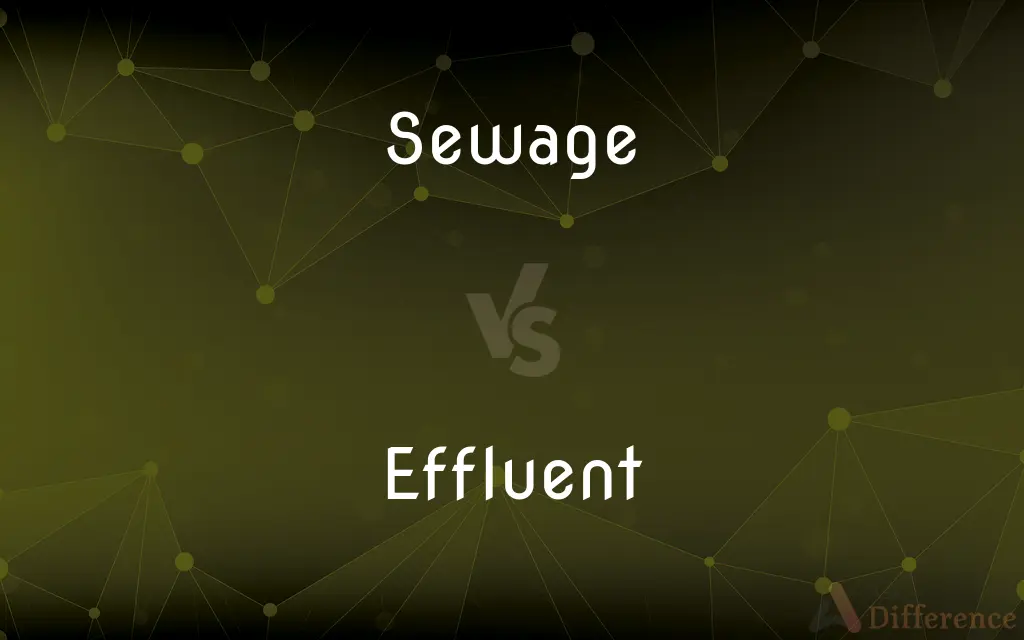Sewage vs. Effluent — What's the Difference?
By Maham Liaqat & Urooj Arif — Updated on March 17, 2024
Sewage is waste water and substances from communities; effluent is treated or untreated discharge flowing from a facility.

Difference Between Sewage and Effluent
Table of Contents
ADVERTISEMENT
Key Differences
Sewage refers to the mixture of water and waste from homes, industries, and other buildings that is carried away by sewers for disposal or treatment. It typically contains a variety of contaminants, including organic matter, chemicals, and pathogens. On the other hand, effluent can be the output of a sewage treatment plant, industrial site, or other facility, which has undergone some level of treatment but may still contain pollutants.
Sewage systems are designed to collect and transport sewage to treatment plants where it is processed to remove contaminants before being discharged as effluent. Whereas effluent quality depends on the treatment process and the original composition of the sewage or industrial waste, indicating that not all effluent is created equal.
The primary goal of treating sewage is to protect public health and the environment by reducing pollutants in the water. In contrast, the treatment and discharge of effluent are regulated to ensure that it meets specific standards to minimize its impact on water bodies and ecosystems.
Sewage treatment involves several stages, including primary, secondary, and sometimes tertiary treatment, to progressively remove solids, organic matter, and other pollutants. Effluent, depending on the level of treatment, may still contain certain pollutants but at lower concentrations than the original sewage.
Sewage management is a critical aspect of urban infrastructure, requiring extensive systems of sewers, pumps, and treatment facilities. Effluent management, while related, focuses on the final treatment and discharge, ensuring that it complies with environmental regulations and does not harm aquatic life or water quality.
ADVERTISEMENT
Comparison Chart
Definition
Waste water and substances from communities.
Treated or untreated discharge from a facility.
Source
Homes, industries, and buildings.
Sewage treatment plants, industrial sites.
Contaminants
Organic matter, chemicals, pathogens.
Depends on treatment; can include remaining pollutants.
Treatment Objective
Remove contaminants to protect health and environment.
Meet specific standards to minimize impact on ecosystems.
Treatment Stages
Primary, secondary, tertiary (optional).
Depends on source; may vary in treatment level.
Compare with Definitions
Sewage
Contains organic and inorganic waste from residential and commercial sources.
Sewage treatment plants process millions of gallons of wastewater daily.
Effluent
Reflects the effectiveness of the treatment process.
Improved effluent quality indicates a successful upgrade to the treatment facility.
Sewage
Mixture of water and waste carried away by sewers.
The city's sewage system is designed to prevent flooding and pollution.
Effluent
May contain treated or partially treated wastewater.
The effluent is released into the river, having been treated to remove most contaminants.
Sewage
Treated in stages to remove harmful contaminants.
Advanced sewage treatment facilities employ biological processes for cleaner discharge.
Effluent
Subject to environmental regulations to protect ecosystems.
Stricter regulations require that effluent discharge meet higher purity standards.
Sewage
Carries pathogens that can cause health hazards if not properly treated.
Untreated sewage can contaminate water sources, posing serious health risks.
Effluent
Can impact water quality if not adequately treated.
Excessive nutrients in effluent can lead to algal blooms in lakes.
Sewage
Requires extensive infrastructure for collection and treatment.
New housing developments often require expansions of the existing sewage infrastructure.
Effluent
Discharge from a sewage treatment plant or industrial process.
The effluent from the factory is closely monitored for pollutants.
Sewage
Sewage (or domestic sewage, domestic wastewater, municipal wastewater) is a type of wastewater that is produced by a community of people. It is characterized by volume or rate of flow, physical condition, chemical and toxic constituents, and its bacteriologic status (which organisms it contains and in what quantities).
Effluent
Effluent is an outflowing of water or gas to a natural body of water, from a structure such as a sewage treatment plant, sewer pipe, industrial wastewater treatment plant or industrial outfall. Effluent, in engineering, is the stream exiting a chemical reactor.
Sewage
Liquid and solid waste carried off in sewers or drains.
Effluent
Liquid waste or sewage discharged into a river or the sea
Industrial effluent
Contamination with trade effluents
Sewage
A suspension of water and solid waste, transported by sewers to be disposed of or processed.
Effluent
Flowing out or forth.
Sewage
(obsolete) sewerage.
Effluent
A stream flowing out of a body of water.
Sewage
The contents of a sewer or drain; refuse liquids or matter carried off by sewers
Effluent
An outflow from a sewer or sewage system.
Sewage
Sewerage, 2.
Effluent
A discharge of liquid waste, as from a factory or nuclear plant.
Sewage
Waste matter carried away in sewers or drains
Effluent
Flowing out; outflowing.
Effluent
(countable) A stream that flows out, such as from a lake or reservoir; an outflow; effluence.
Effluent
Sewage water that has been (partially) treated, and is released into a natural body of water; a flow of any liquid waste.
Effluent
Flowing out; as, effluent beams.
Effluent
A stream that flows out of another stream or lake.
Effluent
Water mixed with waste matter
Effluent
That is flowing outward
Common Curiosities
What is effluent?
Effluent is treated or untreated water discharged from a sewage treatment plant, industrial facility, or other sources.
How is sewage treated?
Sewage is treated through primary, secondary, and tertiary processes to remove contaminants before discharge.
What pollutants may be found in effluent?
Pollutants can vary but may include organic matter, nutrients, chemicals, and pathogens, depending on the treatment level.
Is effluent hazardous?
It can be if not properly treated, as it may contain harmful pollutants and pathogens.
Why is sewage treatment necessary?
To protect human health and the environment by reducing water pollution and preventing the spread of disease.
What is sewage?
Sewage is wastewater that includes domestic, industrial, and stormwater runoff, containing various contaminants.
Can effluent be reused?
Treated effluent can be reused for irrigation, industrial processes, and even as potable water after further treatment.
What is primary sewage treatment?
Primary treatment involves the physical separation of solid waste from the water.
Are there regulations for discharging effluent?
Yes, there are strict regulations and standards to ensure effluent discharges do not harm the environment or public health.
What is the difference between sewage and wastewater?
Sewage is a type of wastewater specifically from domestic or municipal sources, while wastewater can come from various sources.
What advancements are being made in sewage treatment?
Technological advancements are focusing on improving efficiency, reducing energy consumption, and enhancing the removal of contaminants.
How does effluent affect water bodies?
Untreated or inadequately treated effluent can harm aquatic ecosystems, degrade water quality, and affect human health.
What role do sewage treatment plants play?
They process sewage to remove contaminants, producing effluent that is safer for discharge into the environment.
How is effluent monitored?
Effluent quality is monitored through regular testing for specific pollutants, ensuring compliance with regulations.
What is secondary sewage treatment?
Secondary treatment uses biological processes to degrade organic pollutants in the sewage.
Share Your Discovery

Previous Comparison
Benediction vs. Invocation
Next Comparison
Echidna vs. PorcupineAuthor Spotlight
Written by
Maham LiaqatCo-written by
Urooj ArifUrooj is a skilled content writer at Ask Difference, known for her exceptional ability to simplify complex topics into engaging and informative content. With a passion for research and a flair for clear, concise writing, she consistently delivers articles that resonate with our diverse audience.














































